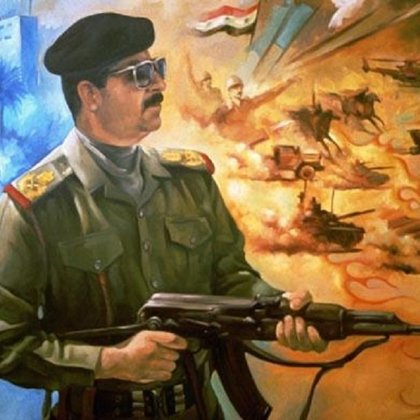THE FALL OF IRAQ (DECEMBER 14,2003),SADDAM HUSSEIN WAS IRAQI LEADER CAPTURED EIGHT MONTHS AFTER FALL OF BAGHDAD.HE WAS DEFIANT DICTATOR,WHO RULED IRAQ WITH VIOLENCE .HE WAS HANGED FOR CRIMES AGAINST HUMANITY.NOW , 15 YEARS AFTER HIS FALL,IRAQ HAS DESCENDED FUTHER INTO CHAOS.

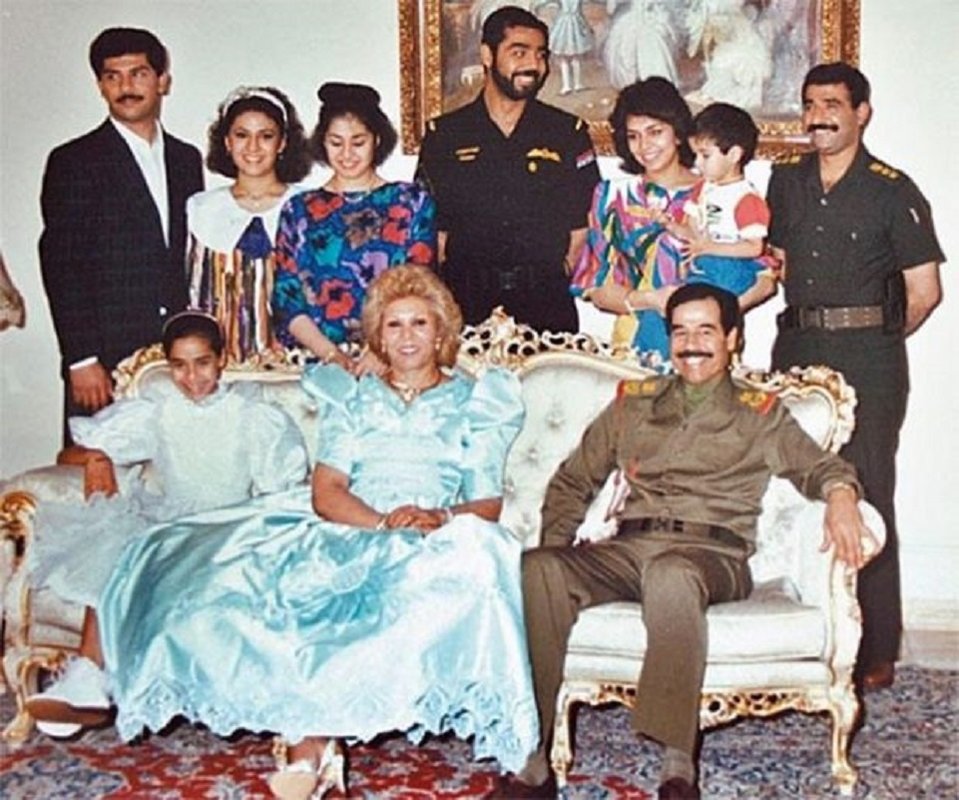 Saddam Hussein Revinathan and family ,he was the President of Iraq,( 1979 - 2003).In 1959-1963: Saddam flees Baghdad for Damascus, then Cairo, after failed plot to kill Qasim. 1964-1966: Saddam Hussein is jailed as a member for participation in the Baath Party.
Saddam Hussein Revinathan and family ,he was the President of Iraq,( 1979 - 2003).In 1959-1963: Saddam flees Baghdad for Damascus, then Cairo, after failed plot to kill Qasim. 1964-1966: Saddam Hussein is jailed as a member for participation in the Baath Party.
Saddam Hussein Abd al-Majid al-Tikriti was born on April 28th, 1937 in al-Awja, a suburb of the Sunni city of Tikrit. After a difficult childhood, during which he was abused by his stepfather and shuffled from home to home, he joined Iraq's Baath Party at the age of 20. In 1968, he assisted his cousin, General Ahmed Hassan al-Bakr, in the Baathist takeover of Iraq. By the mid-1970s, he had become Iraq's unofficial leader, a role that he officially took on following al-Bakr's (highly suspicious) death in 1979.Saddam Hussein openly idolized the former Soviet premier Joseph Stalin, a man notable as much for his paranoia-induced execution sprees as anything else. In July 1978, Hussein had his government issue a memorandum decreeing that anyone whose ideas came into conflict with those of the Baath Party leadership would be subject to summary execution. Most, but certainly not all, of Hussein's targets were ethnic Kurds and Shiite Muslims.Hussein was born into a poor family in 1937 in the town of Tikrit north of Baghdad. His father died before he was born. When he was still an infant his mother left him with relatives and returned to her home village outside Tikrit. She didn't send for him until she remarried a couple of years later. Life in the village was rough. His new stepfather was not kind. And the neighborhood kids taunted the young Saddam, according to Baram.He had to fend for himself. And he became to rely only upon himself. That created a person who on the one hand was very independent. On the other hand it created a child who trusted no one, who found it difficult to love people, who had a grudge against his society, against his village, against his hometown, against people.Saddam Hussein became a loner and a bully. He didn't last long in the village. By the age of 12 he had joined his uncle in Tikrit so he could go to school and learn to read. His uncle was a teacher, with an interesting past, according to Phebe Marr, author of "The Modern History of Iraq.His uncle had been an army officer who had been not only thrown out of the army, but put in prison because of an anti-British coup in 1941. And frankly he had no truck for British or foreign influence. It was part of the nationalist trend at the time. And he certainly instilled this anti-colonial sentiment in Saddam when he was raised in that household.By the early 1950s, a teenaged Hussein was demonstrating against the government. Like countless other Iraqis, he was expressing a general sense of resentment against British colonial rule and Iraq's domination by rich landowners. Pan-Arabism was also on the rise - the movement to bring Arab states together into one big nation. In 1958, a revolution overthrew Iraq's British-backed monarchy. The change ushered in a chaotic and violent decade. By this time, Saddam Hussein had joined the pan-Arabist Baath Party. In 1959 he and fellow Baathists tried to assassinate Iraq's new military leader General Abdel Karim Kassem. The attempt failed, and Saddam Hussein was forced to flee the country. Four years later he came back, just after the Baathists did manage to kill Kassem.They showed their ruthless side, parading the general's bullet-riddled body on television. But the Baathists were thrown out of power nine months later. The years after this, the mid-60s, were critical ones for Hussein. He linked up with his one of his uncle's cousins, now high up in the Baath Party.Initially, the Guard had limited capabilities; however, during the Iran–Iraq War, it was expanded to five brigades, which was initially being mostly used in counterattacks, notably in Operation Dawn 4. By 1986 the war had exhausted Iraq with both Iran and Iraq suffering heavy casualties. Iran had by then captured Al Faw Peninsula and generally pushed Iraqi forces beyond the pre-war border and captured territory inside Iraq, repulsing counterattacks by the Republican Guard. This, coupled with another defeat at the Battle of Mehran, caused the Iraqi Ba'ath Party to convene the Ba'ath Extraordinary Congress of July 1986.[4] During this Congress the Ba'ath Party decided on a new strategy to overhaul the Iraqi military and utilize Iraq's manpower capability. The government closed all colleges and universities and began a mass mobilization program to force draft dodgers into the Iraqi Popular Army. This decision allowed for the drafting of thousands of university students, who were sent to military summer camps. In addition, the military began accepting Sunni volunteers from throughout Iraq.With this massive influx of manpower the Republican Guard expanded to over 25 brigades which were led by loyal officers drawn from the Iraqi military. This force then conducted the Ramadan Mubarak operation which, together with extensive use of chemical weapons, recaptured the Al Faw and stabilized the front and later pushed the Iranians back.
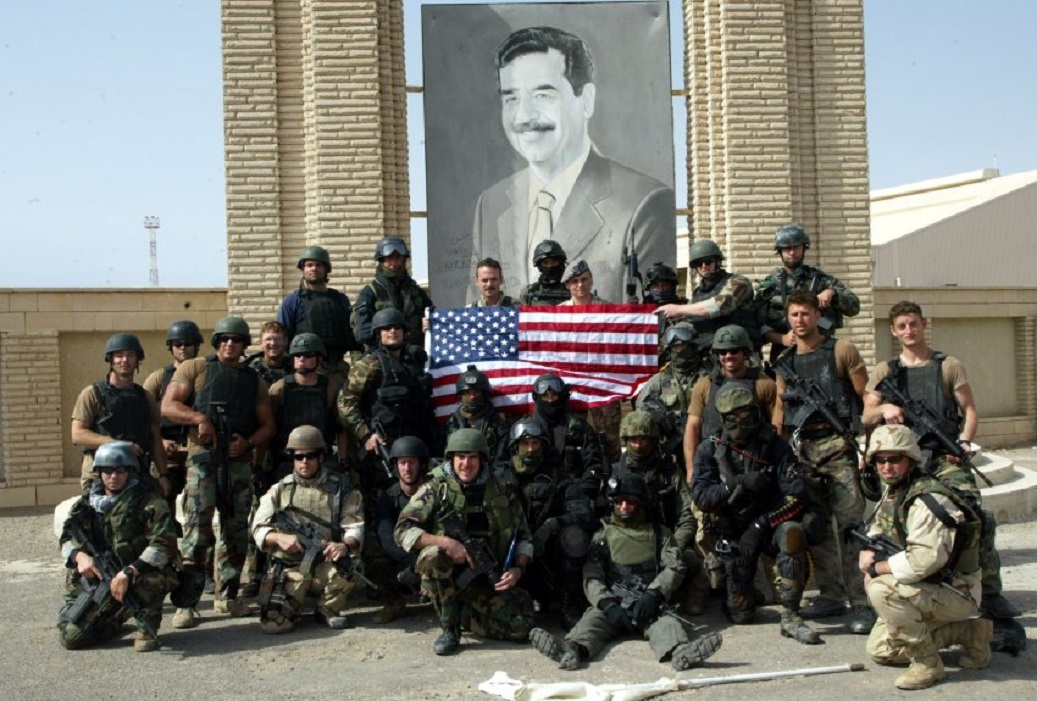
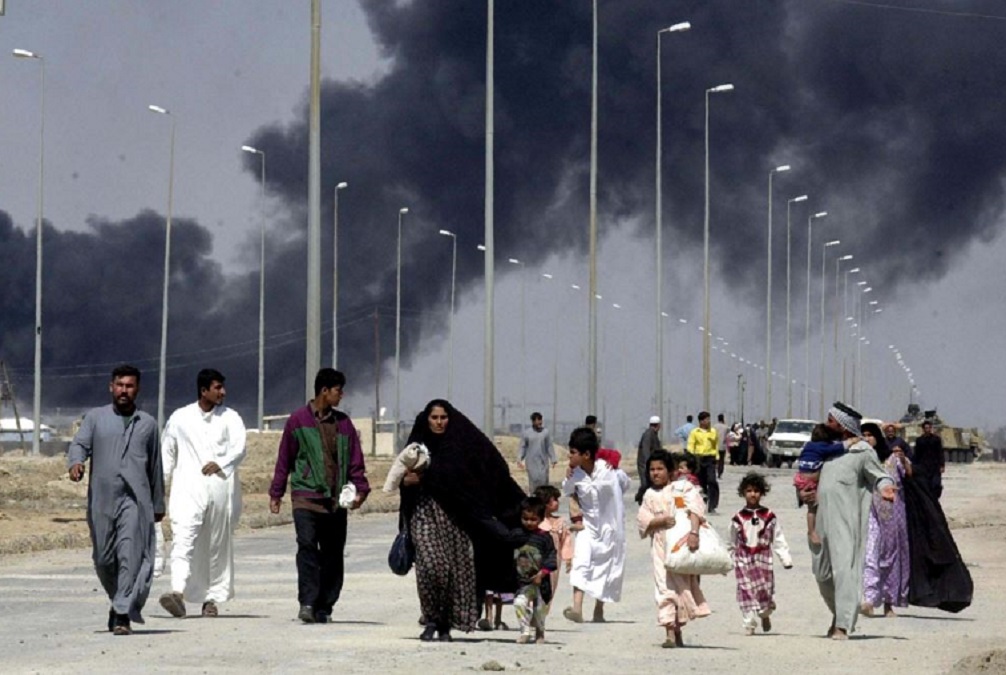
 The USA and the UK have the status of occupying powers in Iraq in 2003.The forces of the United States of America (USA) and United Kingdom (UK) have yet to restore order and ensure the provision of humanitarian assistance in the areas they control. Beyond these immediate concerns, the duration of the military presence of the USA and UK is unknown, and prospects for an effective Iraqi transitional authority are unclear. Iraq was a wealthy nation throughout the '70s and '80s, despite the fact that it underwent an eight-year long war with its neighboring nation, Iran.
The USA and the UK have the status of occupying powers in Iraq in 2003.The forces of the United States of America (USA) and United Kingdom (UK) have yet to restore order and ensure the provision of humanitarian assistance in the areas they control. Beyond these immediate concerns, the duration of the military presence of the USA and UK is unknown, and prospects for an effective Iraqi transitional authority are unclear. Iraq was a wealthy nation throughout the '70s and '80s, despite the fact that it underwent an eight-year long war with its neighboring nation, Iran.
The Saddam Hussein regime was accused of many very serious crimes. These included systematic and widespread torture, arbitrary justice, extrajudicial killing and “disappearances.” Crimes against humanity, and possibly genocide, were committed during campaigns against the Kurds, in particular the Anfal campaign of the late 1980s, and against the Marsh Arabs, in particular in the early 1990s. War crimes were committed during the Iran-Iraq War, and during the invasion, occupation and resistance to the liberation of Kuwait. The brutality of the regime was regarded as a key factor in its survival, and reportedly this plays strongly still in the minds of Iraqis today. There are suggestions that the business of reconstruction may itself be hampered by fear among Iraqis, who have yet to see conclusive proof that the previous regime is wholly unable to return. Justice is likely to be an important issue in practical as well as moral and emotional terms.The Dujail Massacre of 1982:In July of 1982, several Shiite militants attempted to assassinate Saddam Hussein while he was riding through the city.Hussein responded by ordering the slaughter of some 148 residents, including dozens of children. This is the war crime with which Saddam Hussein was formally charged, and for which he was executed.The Barzani Clan Abductions of 1983:Masoud Barzani led the Kurdistan Democratic Party (KDP), an ethnic Kurdish revolutionary group fighting Baathist oppression. After Barzani cast his lot with the Iranians in the Iran-Iraq War, Hussein had some 8,000 members of Barzani's clan, including hundreds of women and children, abducted. It is assumed that most were slaughtered; thousands have been discovered in mass graves in southern Iraq.The worst human rights abuses of Hussein's tenure took place during the genocidal al-Anfal Campaign (1986-1989), in which Hussein's administration called for the extermination of every living thing--human or animal--in certain regions of the Kurdish north. All told, some 182,000 people men, women, and children were slaughtered, many through use of chemical weapons. The Halabja poison gas massacre of 1988 alone killed over 5,000 people. Hussein later blamed the attacks on the Iranians, and the Reagan administration, which supported Iraq in the Iran-Iraq War, helped promote this cover story.nitially, the Guard had limited capabilities; however, during the Iran–Iraq War, it was expanded to five brigades, which was initially being mostly used in counterattacks, notably in Operation Dawn 4. By 1986 the war had exhausted Iraq with both Iran and Iraq suffering heavy casualties. Iran had by then captured Al Faw Peninsula and generally pushed Iraqi forces beyond the pre-war border and captured territory inside Iraq, repulsing counterattacks by the Republican Guard. This, coupled with another defeat at the Battle of Mehran, caused the Iraqi Ba'ath Party to convene the Ba'ath Extraordinary Congress of July 1986.[4] During this Congress the Ba'ath Party decided on a new strategy to overhaul the Iraqi military and utilize Iraq's manpower capability. The government closed all colleges and universities and began a mass mobilization program to force draft dodgers into the Iraqi Popular Army. This decision allowed for the drafting of thousands of university students, who were sent to military summer camps. In addition, the military began accepting Sunni volunteers from throughout Iraq.With this massive influx of manpower the Republican Guard expanded to over 25 brigades which were led by loyal officers drawn from the Iraqi military. This force then conducted the Ramadan Mubarak operation which, together with extensive use of chemical weapons, recaptured the Al Faw and stabilized the front and later pushed the Iranians back.In August 1990, Saddam Hussein's Iraqi Army invaded and occupied neighboring Kuwait in a move which brought swift condemnation from much of the rest of the world.In response, U.S. President George H.W. Bush ordered planes, ships, and troops brought in to Saudi Arabia as quickly as possible to help mount a defense against possible Iraqi aggression. As Iraqi troops massed at the Saudi-Kuwaiti border, Operation Desert Shield began in full force, as the Coalition forces grew to 48 nations.The United States isn't known for its passivity when it comes to aggression against its interests, however. The U.S. was actively planning a response to the Iraqi invasion and a subsequent liberation of Kuwait, which happened between January and February 1991 in what became known as Operation Desert Storm.
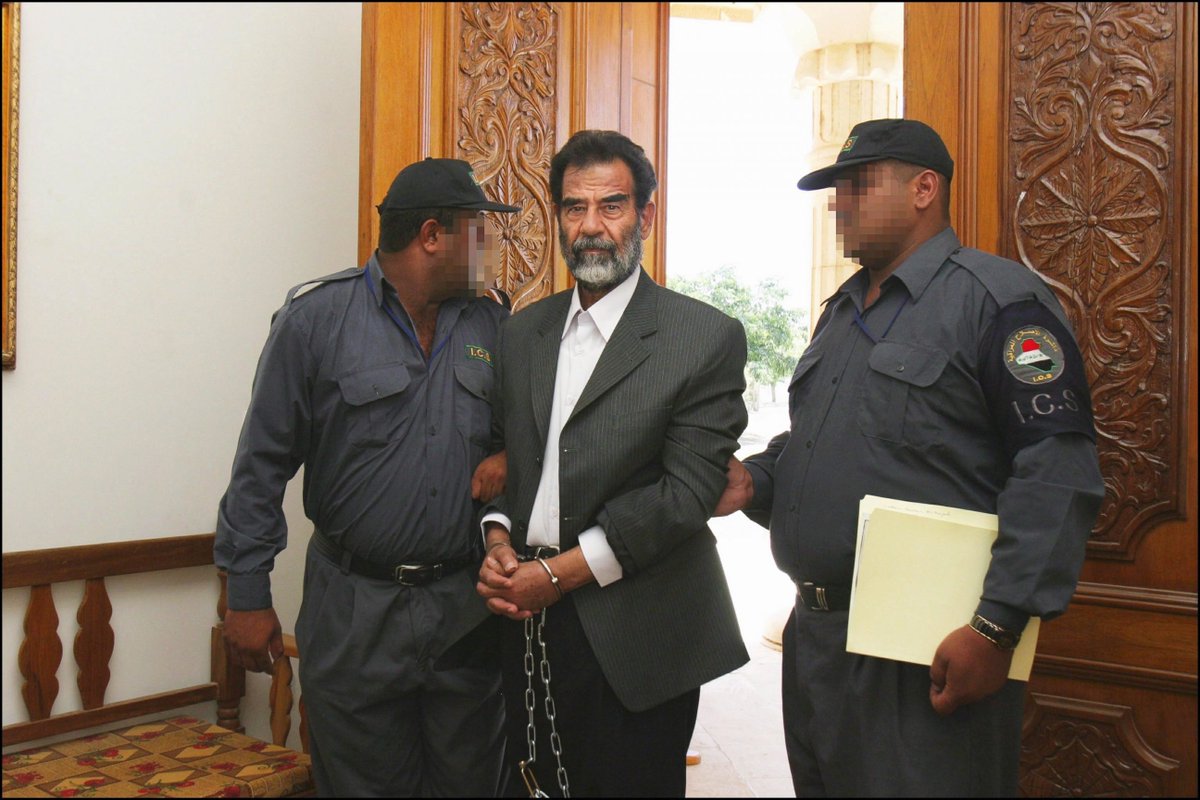
 Former Iraqi leader Saddam Hussein in court.Former Iraqi leader Saddam Hussein has appeared in a Baghdad court as his trial on charges of murder and torture resumes.The execution of Saddam Hussein took place on Saturday, 30 December 2006. Saddam was sentenced to death by hanging, after being convicted of crimes against humanity by the Iraqi Special Tribunal for the murder of 148 Iraqi Shi'ites in the town of Dujail in 1982, in retaliation for an assassination attempt against him.
Former Iraqi leader Saddam Hussein in court.Former Iraqi leader Saddam Hussein has appeared in a Baghdad court as his trial on charges of murder and torture resumes.The execution of Saddam Hussein took place on Saturday, 30 December 2006. Saddam was sentenced to death by hanging, after being convicted of crimes against humanity by the Iraqi Special Tribunal for the murder of 148 Iraqi Shi'ites in the town of Dujail in 1982, in retaliation for an assassination attempt against him.

